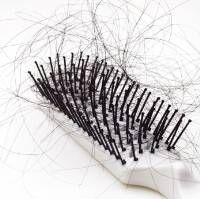Alopecia is loosely defined as hair loss. There are many types of alopecia symptoms, caused by many different factors. Hair loss can be genetic, self-induced, partial, total, caused by drugs, diseases or medical treatment, caused by parasites, or stress-related. While these are only a few of the possible causes for hair loss, it’s important to know that only a medical doctor can diagnose the correct cause of your condition and then recommend the necessary treatment. Before you try any treatments on your own, see a physician. You’ll save time and money and will be on the right path to combating your hair loss effectively. This article discusses some of the more common forms of alopecia symptoms, along with causes and treatment.
Click Here To Match Alopecia Symptoms With The Best Treatment!
One of the many alopecia symptoms is demonstrated by the condition alopecia areata. A bare patch appears on the scalp about an inch across. Thought to be an autoimmune disease, the body’s immune system attacks the follicle. This causes the hair to stop growing and enter a dormant phase. Eventually, the hair will fall out. To regrow the hair, a mechanism must be found to keep the white blood cells of the immune system from assaulting the follicle. There are 2 variants of this condition: alopecia totalis (loss of all scalp hair) and alopecia universalis (loss of all body hair). Topical treatments include corticosteroids, dithranol, Retin-A, minoxidil and zinc. Medicinal treatments include systemic cortisone and immunosuppresant drugs.
Androgenic alopecia, better known as male pattern baldness, is the most common type of hair loss in men. Alopecia symptoms for this condition include receding hairline and thinning hair at the temples and crown. Caused by a combination of genetic and hormonal factors, this type of alopecia is triggered by the hormone dihydrotestosterone (DHT). If you carry the genetic predisposition for overproduction of DHT, your body produces too much of an enzyme called 5 alpha reductase. This enzyme causes too much DHT to be produced. DHT attacks the follicle, causing the hair shafts that emerge to be thinner and thinner. Finally they become transparent and disappear altogether. Treatments include DHT blockers or 5 alpha reductase blockers like minoxidil and finesteride. Retin-A and zinc have also seen some success. An effective herbal treatment is saw palmetto extract.
Anagen effluvium is another cause of alopecia. Certain types of medical treatment, such as chemotherapy cause anagen effluvium. This treatment depresses the immune system, so that anticarcinogenic drugs can destroy the rapidly-growing cancer cells. This systemic weakness extends to the hair follicles. Alopecia symptoms for this type of hair loss are generally sudden and complete, with the hair coming out in large clumps. This type of alopecia is temporary and many people claim that when their hair regrows, it is thicker and healthier than before. There have even been cases where straight hair grows back curly and vice versa.
In telegen effluvium hair loss is causes by a sudden stressful event or severe emotional stress.
Hair stops growing and the follicle becomes inactive or dormant. This dormancy phase lasts about 3 months, after which the hair will fall out. In most cases the alopecia symptoms are temporary but sometimes remains until the underlying stress or emotional condition is identified and treated.
Systemic illness is often responsible for alopecia symptoms like thinning or sudden and complete hair loss. Diseases like overactive thyroid, underactive thyroid, diabetes, lupus and anemia often have hair loss as a secondary symptom. Again, the hair loss is usually temporary, but the cause must undergo treatment for the hair to regrow.
Alopecia symptoms are as varied and complex as the underlying causes. Many men make the mistake of self-treating and are disappointed when the treatment doesn’t work. You should discuss your hair loss with your doctor. Only he will be able to order the correct tests and provide a specific diagnosis. Then you’ll get treatment tailored to your specific situation that is more likely to succeed.
Click Here To Match Alopecia Symptoms With The Best Treatment!

